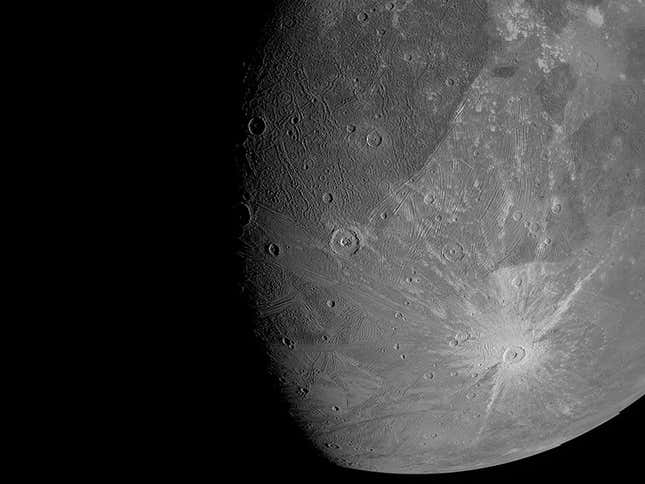
NASA’s Jupiter-orbiting Juno spacecraft was able to capture new images of the moon Ganymede during a close flyby on Monday. The natural satellite, the biggest moon in the solar system, has an icy surface that covers an interior of rock and iron.
Juno had a little less than half an hour to observe Ganymede at close range; that was enough time for five images, if all went well. The above image—taken using the JunoCam visible-light imager—covers about 0.6 miles of the moon per pixel. Swathes of icy plains, pockmarks of massive craters, and long streaks (possibly of tectonic origins, according to NASA) are visible in this thrilling view.
“This is the closest any spacecraft has come to this mammoth moon in a generation,” said Scott Bolton, principal investigator of Juno at the Southwest Research Institute in San Antonio, in a NASA press release. “We are going to take our time before we draw any scientific conclusions, but until then we can simply marvel at this celestial wonder—the only moon in our solar system bigger than the planet Mercury.”

The image was captured using the green filter on JunoCam; still to come are images using the camera’s red and blue filters, which together will give us a color portrait of Ganymede. Also released today is an image of Ganymede’s dark side, taken by Juno’s Stellar Reference Unit navigation camera.

Aside from these surface views of Jupiter’s moon—one of planet’s 79 known satellites—the NASA team is expecting data from the probe on Ganymede’s upper atmosphere and its magnetosphere. Though it may look a lot like Earth’s Moon at first glance, this orb is a lot more complex: It’s the only moon known to have a magnetic field, and scientists also believe it has a salty, subsurface ocean.
More: NASA Spacecraft Has a Close Encounter with Jupiter’s Moon Ganymede